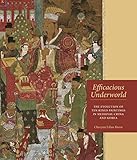Efficacious Underworld : The Evolution of Ten Kings Paintings in Medieval China and Korea / Cheeyun Lilian Kwon.
Material type: TextPublisher: Honolulu : University of Hawaii Press, [2019]Copyright date: ©2019Description: 1 online resource : 120 color, 80 b&w illustrationsContent type:
TextPublisher: Honolulu : University of Hawaii Press, [2019]Copyright date: ©2019Description: 1 online resource : 120 color, 80 b&w illustrationsContent type: - 9780824856021
- 9780824856052
- 759.951 23
- ND1043.43 .K866 2019
- online - DeGruyter
- Issued also in print.
| Item type | Current library | Call number | URL | Status | Notes | Barcode | |
|---|---|---|---|---|---|---|---|
 eBook
eBook
|
Biblioteca "Angelicum" Pont. Univ. S.Tommaso d'Aquino Nuvola online | online - DeGruyter (Browse shelf(Opens below)) | Online access | Not for loan (Accesso limitato) | Accesso per gli utenti autorizzati / Access for authorized users | (dgr)9780824856052 |
Browsing Biblioteca "Angelicum" Pont. Univ. S.Tommaso d'Aquino shelves, Shelving location: Nuvola online Close shelf browser (Hides shelf browser)

|

|

|

|

|

|

|
||
| online - DeGruyter Japanese Feminist Debates : A Century of Contention on Sex, Love, and Labor / | online - DeGruyter A Tokyo Anthology : Literature from Japan's Modern Metropolis, 1850-1920 / | online - DeGruyter Youth for Nation : Culture and Protest in Cold War South Korea / | online - DeGruyter Efficacious Underworld : The Evolution of Ten Kings Paintings in Medieval China and Korea / | online - DeGruyter Traces of Trauma : Cambodian Visual Culture and National Identity in the Aftermath of Genocide / | online - DeGruyter Accounts and Images of Six Kannon in Japan / | online - DeGruyter Feasting in Southeast Asia / |
Frontmatter -- CONTENTS -- Introduction -- EVOLUTION OF TEN KINGS PAINTINGS IN CHINA -- Introduction -- 1. Images of the Ten Kings: Early Traces -- 2. Transitional Link from Handscroll to Individualized Hanging Scrolls: The Former Packard Set -- 3. Full Efflorescence in Southern Song Ningbo -- 4. Post-Song Variations -- THE TEN KINGS CULT IN KORYŎ -- Introduction -- 5. Buddhist Rituals and the Ten Kings Paintings in Koryŏ -- 6. The Scripture on the Ten Kings from Haeinsa (1246) -- THE TEN KINGS FROM THE SEIKADŌ BUNKO ART MUSEUM -- 7. Introduction to the Seikadō Ten Kings -- 8. The Seikadō Ten Kings as Iconic Images -- 9. Northern Song Figure-Painting Styles in the Seikadō Ten Kings -- 10. Northern Song Landscape- and Flower-Painting Styles in the Seikadō Ten Kings -- 11. Ritual Context: Royal Ancestral Worship in the Buddhist Style -- Conclusion -- Appendix -- Glossary -- Notes -- Bibliography -- Illustration Credits -- Index -- ABOUT THE AUTHOR
restricted access online access with authorization star
http://purl.org/coar/access_right/c_16ec
The Ten Kings hanging scrolls at Tokyo's Seikadō Bunko Art Museum are among the most resplendent renderings of the Buddhist purgatory extant, but their origin and significance have yet to be fully explored. Cheeyun Kwon unfurls this exquisite set of scrolls within the existing Ten Kings painting tradition while investigating textual, scriptural, archaeological, and visual materials from East Asia to shed light on its possible provenance. She constructs a model scheme of the paintings' evolution based on more than five hundred works and reveals channels of popularization, mass production, and agglomeration.The earliest images of the Ten Kings are found in the tenth-century sūtra The Scripture of the Ten Kings, known to be the work of the monk Zangchuan. By the mid-twelfth century, typological conventions associated with the Ten Kings were widely established, and paintings depicting them, primarily large-scale and stand-alone, became popular export commodities, spreading via land and sea routes to the Korean peninsula and the Japanese archipelago. An examination of materials in Korea suggests a unique development path for Ten Kings subject matter, and this-in conjunction with a close analysis of the Seikadō paintings-forms the core of Kwon's book. Among the Korean works discussed is a woodblock edition of The Scripture of the Ten Kings from 1246. It is markedly different from its Chinese counterparts and provides strong evidence of the subject's permutations during the Koryŏ period (918-1392), when Northern Song (960-1127) visual art and culture were avidly imported. In the Seikadō paintings, Northern Song figural, architectural, landscape, and decorative elements were acculturated to the Koryŏ milieu, situating them in the twelfth to early thirteenth centuries and among the oldest and most significant surviving examples of Koryŏ Buddhist painting.Efficacious Underworld fills major lacunae in Korean, East Asian, and Ten Kings painting traditions while illuminating Korea's contribution to the evolution of a Buddhist theme on its trajectory across East Asia. With its rich set of color reproductions and detailed analysis of textual and visual materials, this volume will invite significant revision to previously held notions on Koryŏ painting.
Issued also in print.
Mode of access: Internet via World Wide Web.
In English.
Description based on online resource; title from PDF title page (publisher's Web site, viewed 02. Mrz 2022)


